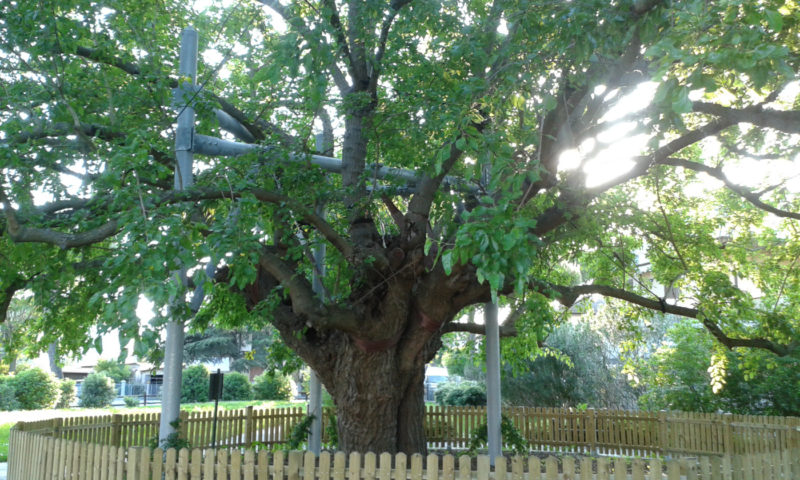
Gelso di Cervia
This post is also available in:
 Italiano (Italian)
Italiano (Italian)
Morus alba (Moraceae)
This magnificent white mulberry is what remains of Emilia Romagna’s tradition of inserting mulberries to vine rows in order to support them and to produce leaves for the breeding of silkworms, an activity which ended after the Second World War.
The white mulberry tree of Cervia grew at the border of some cultivated fields, but now it is surrounded by the results of urbanisation processes of the following years.
The monumental tree is bred in halter and it has been kept, till urbanisation times, in the mandatory form, the so called “testa di salice”, to produce great quantities of leaves.
The circumference of the trunk is of 4.75m, various principal limbs depart not so far away from the soil and they are putting to the test the tree’s stability.
In 1995 it has been done and exceptional transplanting and the mulberry has been moved of about 10 m, because a road had to be constructed in its rooting point.
In 2012 a strong wind has caused the cave in of a limb, which has been shored up.
Recently, after the fall of 2012, it has become more and more urgent to plan stabilisation interventions, which have taken place in the March of 2017. These interventions has led to the construction of a provisional scaffolding which was added to a permanent of one made of light metallic pillars and regulable cables, which can facilitate the movements of the mulberry. In addition, it has been constructed a surrounding corral to avoid foot traffic and the superficial soil has been substituted with some volcanic material and compost.
This majestic tree is more than 200 years old and it is the symbol of silk production, which merits with no doubt a visit.
How to reach it:
The municipality of Cervia (RA) is located along Romagna’s shore and the monumental tree is in via Catullo.
Botanical characteristics :
They come from China and have arrived in Europe in ancient times, while they were introduced in 1130 in Italy thanks to Roger II.
They are cultivated in rows mainly in the Po valley in order to feed silkworms during the 19th century, while Italy was one of the centres for the production of silk together with China and Japan.
The species prefers fresh, deep, non-clayish, permeable and with no water stagnation soils.
White mulberries vegetate well between 0 and 700 m of height .
Their leaves and roots can be used for officinal aims, while their fruits are sugary and can be used to produce marmalades and syrups, but it is not possible to sell them as fresh fruits because of their extreme perishability to the touch.
FOTO: https://ioinviaggio.wordpress.com/2017/05/19/il-gelso-bianco-di-cervia/
This post is also available in:
 Italiano (Italian)
Italiano (Italian)
Contatti
48015 Cervia(RA)
